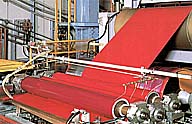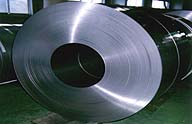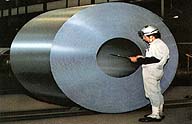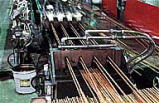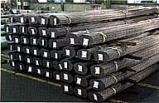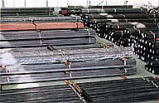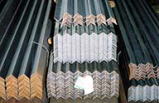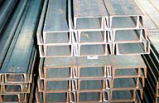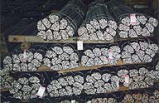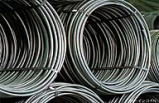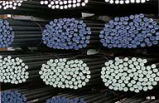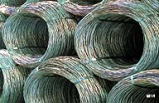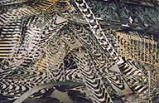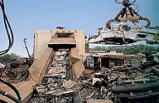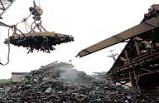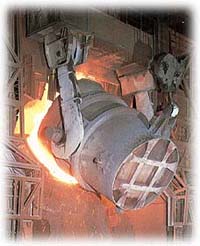 |
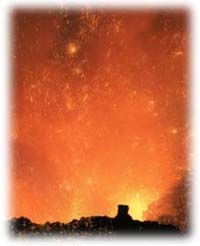 |
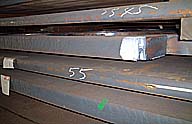 |
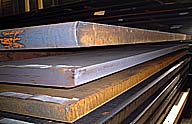 |
ügAfter adjusting elements and controlling temperature in accordance with theprocessing conditions and the fields they will be used in, melted iron iscompressed to 6 ~ 250mm thick, 1~ 5m wide, 3m to 20m long at an iron foundrywith a 6-step rolling mill. The result is a thick steel plate.
This thick steel plate is used in a wide variety of fields: shipbuilding , frames of buildings or bridges, pipelines for oil or gasexploration, cranes or power shovels for heavy construction, industrial machinery, and presses or oil tanks for industrial districts. It is put tovarious uses in all the important parts of our lives.
The resulting thick steel plate is sent to the end-users from the mill.Being wide, long, and heavy, it is transported by ship or oversized tractor trailer truck. After unloading by gantry cranes, it is cut into designated sizes with oxy-acetylene gas cutting and then welded into their shapes as vessels and other applications that we find everywhere.
Since iron rusts easily, rustproofing pre-treatment is conducted to prevent the metal from rusting at an iron mill if requested by the users and then it will be shipped.
The above is a simple explanation of what a thick plates is. It is used for the buildings, bridges, and storage tanks that we see often see on TV or in magazines every day. From now on, whenever you have a chance to see some prominent structures somewhere, remember "What's thick steel plate?"
Uses of Thick Steel Plate
Construction,Containers,Vehicles,Metal Molds,Bridges Structures,Construction
Machinery,Maritime Vessels
 |
High temperature lumps of iron produced from ironstone or coal are compressed until they are 0.15~several mm in thickness. The result is a thin steel plate. There are a variety of thicknesses, materials and the kinds of surfaces that have different uses. The facilities or methods used for
production are varied accordingly.
A thin plate is used in a wide variety of applications; in the consumer appliances field, like with refrigerators or air conditioners; the construction field, like with roofs, walls, shutters or doors; the automotive field; the tinplate field, like with food container-packaging; and, the magnetized-steel sheet field, like with transformers, motors and dynamos. A thin plate sheet is an essential product in our daily lives.
The main kinds of thin plate include a hot-rolled steel sheet, a cold rolled steel sheet, a fusion galvanized steel sheet, an electro-galvanized steel sheet, a coated-steel plate, tinplate, and magnetized-steel sheet. Each of them has a variety of uses and production methods, depending on individual customer's needs.
Recently, thin steel sheeting has been produced with environmentally friendly materials and it has become one of the most important requirements for a good product to possess. The steel industry is no exception. With earth-friendly efforts, this product has a wide variety of "earth-friendly products." For example, tinplate, which is used for cans, can be easily recycled compared to other materials for packaging-containers. There is also a chromate-free steel plate with no chromate involved, a major component which is about to be prohibited for use in some countries for environmental reasons. There is also a steel plate resistant to corrosion to such an extent that coating or plating is unnecessary. There is also a high-tensile steel sheet, which is used for the reduction of vehicle weight and the improvement of fuel efficiency due to its thinness and strength. These are some of the examples of the products utilizing thin steel plating. We are seeing more and more such high-value products that meet the needs of the present age.
It is more than certain that a thin sheet metal is increasingly becoming important in our life.
 |
A pipe is also called a steel pipe. It's usually in a hollow cylindrical shape made of steel, such as what you see with a laundry pole.
There are various methods to produce a steel piping, but the most common method is to weld both edges of a steel coil together into a round shape called a pipe.
It may be easy to imagine the paper towel dispenser in your home; while pulling the end of the paper toward you, glue both sides of the paper and the paper will be form itself into a cylindrical shape. The same goes with a steel coil; while the end of the coil is being pulled, both sides are able to be welded into a similar round shape.
A pipe is used in various places, both visible and invisible. Gas pipes or water pipes are routinely used for sending gas or water into each and every household. This is only one of the examples. Just look around you and you will find a pipe near you.
 |
There are many kinds of shaped steel according to its uses or purposes.
Here are some explanations for what a bar steel, a flat steel, a H-section
steel and a general shaped steel are.
Bar steel is generally called "a reinforcing steel," (sometimes called "rebar") which is used for architectural construction such as reinforced-steel concrete structures or steel-framed reinforced concrete structures.
An H-section steel is a beam that is hot-rolled into an H-shaped cross-section.
It is used in a variety of ways; such as a construction material, a constructional member for bridges, machines and vehicles; civil engineering uses such as falsework and posts for tunnel construction.
A flat sheet is a beam whose cross-section surface is rectangular in shape. It is used in a variety of fields, as with a thick steel plate; for construction, shipbuilding, vehicles, consumer appliances and other applications.
General-shaped steel includes an equal angle bar, I-section steel and channel steel. Generally it is widely used for construction, steel towers, shipbuilding and machinery fabrication, as well as in the construction of private dwellings.
*The sentences are quoted from "The Recent Electric Furnace Steel",
 |
The words "special steel are often used rather than "plain steel"
to describe this product.
It's an alloy made so that special properties are given through a mixture of certain metallic elements during the first step of the steelmaking process. According to its applications, it is given greater tensile strength, ease of process, low-thermal conductance or resistance to corrosion.
Special steel contains a high amount of carbon, in which usually various alloy elements have been added. It is also called "tempered steel" which is steel subjected to heat treatment since it is given higher strength, higher abrasion quality, higher toughness and other mechanical characteristics through the process of heat treatment. For this reason, it is broadly used for the fabrication of mechanical structures and machine parts.
To be specific, it is used as a material for automobile parts and electric appliance parts or as a material for formation of metallic molds.
Stainless steel: knives, forks, etc.
Titanium: eyeglass frames, etc.
Carbon steel; nippers, wrenches, auto parts, etc.
It is used in a wide variety of fields. Look around you, and you will find a lot of special steel products that you have not been aware of yet.
 |
The Sanjo Steel Association has a materials committee. The businesses that belong to the committee deal mainly with raw materials for steel making, raw materials for fabricating molds, and raw materials for papermaking.
Major materials (Materials or products that each business deals with).
*Metal materials: raw materials for steel making, raw materials for molding,raw materials for stainless steel, non-ferrous materials, raw materials for light metals.
*Papermaking materials: raw materials for papermaking
*Others
Raw materials for steel making include the following; scraps of steel, such as clipped scraps produced when steel plates are cold-pressed, scrap powder produced when they are ground, clip scraps when round bars are hot-pressed in the process of manufacturing auto parts, or disposed work tools; steel beam scraps, reinforcing steel scraps, tinplate scraps when buildings are dismantled; unusable steal furniture such as pipe chairs and lockers disposed of by schools or governmental agencies.
After being sorted out, these scraps are pressed or cut or shredded by machines. Then they are delivered to the electric furnace steel makers inside or outside of Sanjo, where they are dissolved and regenerated into products such as round bars, H-section steel or other applications and then put on the market again.
Material for stainless steel consists of scraps of stainless steel after
stainless steel plates are bent or punched out in the process of making western tableware, commercial kitchen utensils, sundry goods for household use, and architectural hardware. They are sorted out, pressed, cut and taken to stainless-steel manufacturers. They are recycled and transformed into stainless sheet plates, wire rods and foundry pieces.
Material for cast metal is mainly from iron scraps from factories or disposed used machine tools and disposed used machines such as sheet metal machines and press machines.
Disposed machines are cut into appropriate sizes after switchboards and motors are removed. Iron scraps are pressed or cut into the proper sizes that fit in the furnace, taken to foundries in Sanjo, Sakae, Nagaoka, Ojiya and other surrounding areas. This material for cast metal is dissolved in electric furnaces or cupolas and made into foundry pieces such as machine tools, manholes, water pipes, auto parts, construction machines,construction architectural hardware, sundry goods for household use, and so on.
Non-ferrous material and light metal material come from factories, ordinary households, electric construction and auto dismantlers.
When utensils or sundry goods are manufactured, sheet copper, sheet brass or aluminum boards are pressed or punched out. In this process, non-ferrous scraps are produced. Also aluminum cans, pots, kettles and aluminum parts of electric appliances and faucet from ordinary households, and auto engines from dismantlers, electric cable scraps from electric construction become non-ferrous material and light metal raw material. They are sorted, broken down. And then after extraneous foreign elements are removed, they are delivered to fusion factories, where they are transformed to non-ferrous plates, light metal plates, wires and foundry pieces.
Papermaking material is from printing plants, corrugated box processing plants, supermarkets, ordinary households and government agencies. Used paper from those places are sorted out and taken to recycled wastepaper wholesalers. There, after plastic codes and other extraneous things are removed, it is pressed and strapped and delivered to papermaking factories in Japan and overseas, where it is dissolved or mixed with wood pulps and recycled into corrugated paper, newspaper, toilet paper, paper bags, books, and so on.
There are numerous things that could become raw materials around you. Please don't waste the limited resources we have, recycle them.





